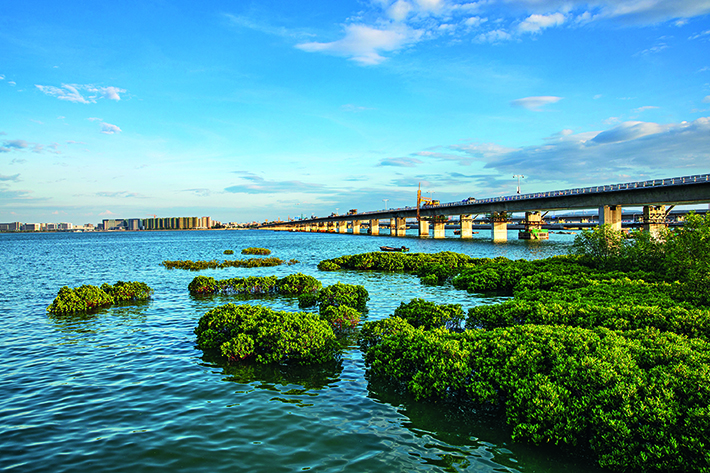|
||||||||||
| Home Top News Economy/Tech Culture/Sports China in Foreign Eyes Green Development Videos Intangible Cultural Heritages |
|
||||||||||
| Home Top News Economy/Tech Culture/Sports China in Foreign Eyes Green Development Videos Intangible Cultural Heritages |
| ChinAfrica |
| A Visionary Strategic Blueprint |
| How a 15-year visionary development plan transformed China’s smallest special economic zone |
| By Zhang Yantao | VOL. 17 August 2025 ·2025-07-24 |

A plane flies over Chaotian Palace in Xiamen (VCG)
In 1985, as China’s reform and opening up gathered momentum, Xiamen Special Economic Zone (SEZ) in southeast China’s Fujian Province remained a small coastal city with limited infrastructure and numerous development challenges. That year, Xi Jinping became a member of the Standing Committee of the Communist Party of China (CPC) Xiamen Municipal Committee and an executive vice mayor of Xiamen. With an area of just 2.5 square km in its early stage, Xiamen was the smallest SEZ in China.
However, Xi keenly recognised the importance of a scientific and strategic plan for the city’s development. During his tenure, he spearheaded the formulation of the Xiamen Economic and Social Development Strategy (1985–2000), mapping out a 15-year development blueprint that laid the groundwork for the city’s sustainable prosperity.

A mangrove forest in Jimei District, Xiamen (VCG)
Pioneering a path
To explore the path to building a free port with Chinese characteristics, Xiamen Daily launched an essay contest in 1986 under the theme “The Xiamen We Want in 2000,” sparking widespread public engagement. Dozens of citizens submitted proposals for the city’s future, and over 10 essays were ultimately incorporated into the strategy.
According to Li Xiuji, then deputy secretary of the CPC Xiamen Municipal Committee, after five years of construction, the SEZ had entered a new phase. There was an urgent need for a fresh development strategy to accelerate progress.
In August 1986, the CPC Xiamen Municipal Committee and Xiamen government adopted Xi’s proposal to establish the Office of Economic and Social Development Strategy Research. One of its key achievements was formulating the Xiamen Economic and Social Development Strategy (1985-2000).
The strategy was grounded in rigorous research. Teams from the office visited Beijing to consult experts and officials, gaining support from renowned economists such as Yu Guangyuan, then member of the CPC Central Advisory Commission, Liu Guoguang, then vice president of Chinese Academy of Social Sciences (CASS), and Dong Fureng, then director of CASS Institute of Economics. Over 100 experts and scholars from institutions including CASS, the Chinese Academy of Sciences, Xiamen University, and relevant government departments contributed to studies on 21 major topics. A delegation also travelled to Singapore to explore free port models and adapt lessons to China’s context.
The strategy played a pivotal role in shaping Xiamen’s development. It was the first to propose concrete steps to partially implement free port policies, including the establishment of the Xiangyu Bonded Area. It also introduced the innovative concept of an “ecological niche,” emphasising the need to protect the environment while pursuing economic growth. Even today, many scholars regard this strategy as visionary, with several of its ideas remaining nationally influential.
Zheng Jinmu, then deputy director of the former Xiamen Municipal Development Planning Commission, recalled how Beijing experts were impressed by the inclusion of “ecological niche” in the plan. “Of the 21 research topics, two focused on ecological civilisation: one on the cultural value and tourism development of Gulangyu Island, and the other on Xiamen’s urban ecosystem. This was rare nationwide at the time.”
Formulated at the SEZ’s inception, the Xiamen Economic and Social Development Strategy (1985-2000) was China’s first 15-year development strategy introduced and implemented by a local government. It provided the impetus for Xiamen’s rapid transformation.
Even after becoming governor of Fujian Province, Xi continued to pay close attention to Xiamen’s development. During a 2002 inspection as deputy secretary of the CPC Fujian Provincial Committee and governor of the province, he identified a pressing issue: limited development space on Xiamen Island and slow progress in surrounding areas. There was an urgent need to expand both the urban centre and its economic hinterland, he noted.
As a solution to this problem, Xi proposed the strategic concept of “upgrading development on the island while encouraging cross-island expansion.” This approach called for integrating island renewal with bay area development, aligning urban transformation with economic transition, and linking rural industrialisation with urbanisation. It also highlighted the importance of ecological conservation in turning Xiamen into a modern, international garden city with a prosperous economy, civilised society, sound spatial layout, and a beautiful environment. This marked the beginning of a new phase of integrated urban development.

Primary school students compete with rubber band powered model airplanes at a science festival in Xiamen on 30 December 2024 (VCG)
Mid- to long-term strategic blueprint
The development strategy was crucial during the early years of the Xiamen SEZ’s development. It clarified the city’s developmental tasks, streamlined the planning process, and helped to avoid missteps and inefficiencies.
Devising a development strategy is a complex endeavour. It requires detailed historical analysis, projections for the future, and coordination across economic, technological, and social sectors. The Xiamen Economic and Social Development Strategy (1985-2000) covered 21 key areas, including urban infrastructure, industrial development, systemic reforms, free port construction, and cooperation with Taiwan Province. It also covered social welfare, environmental protection, heritage conservation in Gulangyu, and population control. Notably, it included forward-looking proposals for intellectual property protection and sustainable development.
The Xiamen Economic and Social Development Strategy (1985-2000) eventually became the strategic blueprint guiding the city’s mid- and long-term development. The esteemed economist Ma Hong remarked that it not only provided vital guidance for Xiamen’s SEZ plans and policies, but also served as a model for other regions developing their own strategic frameworks.
The author is Professor of School of Marxism, Xiamen University
| About Us | Contact Us | Advertise with Us | Subscribe |
| Copyright Beijing Review All rights reserved 京ICP备08005356号-5 京公网安备110102005860号 |